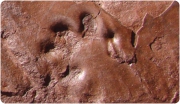The new species is an ornithopod, one of the most diverse, long-lived, and cosmopolitan groups of herbivorous dinosaurs, which includes some emblematic representatives such as iguanodonts and duck-billed hadrosaurs. C. rapidus belongs to the styracosterns and inhabited what today are the Catalan Pyrenees during the final stage of the Cretaceous, approximately 66 million years ago, specifically in the last hundred thousand years of the Mesozoic. This geological era ended with the well-known impact of an asteroid on Earth, which caused the extinction of all non-avian dinosaurs and many other livingorganisms. Therefore, Calvarius rapidus is one of the last dinosaurs that ever walked on the planet.
It is the chronostratigraphic proximity between this mass extinction event and the age of the fossil what has provided the name of this new genus, Calvarius, from the Catalan word ‘calvari’ (‘suffering’) caused to the biosphere by the impact of the asteroid. . The specific epithet rapidus, that means ‘quick’ or ‘fast’ in Latin, and it refers to the likely cursorial adaptations of this animal.
The collected fossil remains of Calvarius are restricted to a long but small metatarsal bone from the left foot. This material was excavated in 2019 at the Masia de Ramon locality, near Figuerola d'Orcau, in the county of Pallars Jussà (Lleida province, northwestern Catalonia). This locality was discovered in 2001 by a team of paleontologists from the Museu de la Conca Dellà (MCD) and the Institut Català de Paleontologia Miquel Crusafont (ICP) while prospecting for fossils in the central Tremp Basin in the Catalan Prepyrenees.
"During the excavations carried out in the locality we found a crocodile vertebra and several unidentified bone fragments along with the remains of the holotype of Calvarius rapidus", says Albert Prieto-Márquez, paleontologist at the Dinosaur Ecosystems research group at ICP who coauthors the study. The bone is relatively well-preserved; "It is a very unusual metatarsal for this group of dinosaurs. Although we only have this specimen, the fact that it shares the main metatarsal morphology of styracostern ornithopods while displaying highly modified traits such as gracile and elongate proportions, clearly indicates that we are dealing with a new species for science within this group", adds the researcher.

The holotype left metatarsal IV of Calvarius rapidus in A, dorsal, B, lateral, C, plantar, and D, medial views.
"The thin and elongated metatarsal proportions of Calvarius reminds to those of small herbivorous dinosaurs that evolved and branched out into their own lineages before the common ancestor of styracosternans", comments Albert Sellés, co-author of the article and researcher at ICP. Thanks to the accumulated knowledge from various studies on the evolutionary life history of styracosterns, along with histological data —the internal structure of the fossil's bone tissues— of the holotype of C. rapidus, we know that the specimen was a late subadult at the time of death. It had not yet approached its growth, but was close to the skeletal maturity, probably achieved between 8 and 10 years of age.
The article published in the Journal of Vertebrate Paleontology highlights that the animal was likely a swift runner. Based on the length of the metatarsal, approximately 15 centimeters, researchers estimate that the animal measured no more than two meters long. "While some species in this group of dinosaurs reached lengths surpassing 10 or 12 meters. Thus, C. rapidus would be the smallest known styracostern dinosaur of the planet", points out Sellés.
These small dimensions led the investigators to hypothesize that this species evolved convergently in relation to the distantly related small gracile herbivore dinosaurs that evolved at the base of the ornithopod dinosaur tree and represents yet another case of endemism in an insular terrestrial environment influenced by the Island Rule. The limited food resources in islands fosters fauna to evolve toward smaller forms or even dwarfism. 66 million years ago, the current territories of northern Spain and southern France formed a large island known as Ibero-Armorica, belonging to a huge archipelago where now stands the European continent.
The geological interpretation of the strata where C. rapidus was found indicates that this animal died near a meandering river, surrounded by abundant shrub-like vegetation and ferns. The climate in the late Cretaceous period in the Pre-Pyrenees was warmer and more humid than it is today, resembling that of subtropical regions, with long periods of drought and periods of torrential rains. Apart from C. rapidus, remains of crocodiles, fish, and small vertebrates such as lizards have also been found at the Masia Ramon locality. This is where the species in question lived, sharing the Ibero-Armorican ecosystems with other dinosaurs as large long-necked titanosaurs and large lambeosaurine hadrosaurids with their distinctive bony crests.
The Pyrenees preserve one of the richest fossil records of the last dinosaurs that lived in Europe before their extinction worldwide. For over three decades, researchers from the Institut Català de Paleontologia Miquel Crustafont have organized excavation campaigns in the region, and their findings have resulted in hundreds of scientific publications documenting life during the last four million years of the Mesozoic in this part of the world.
In parallel, the outreach project "Dinosaurs of the Pyrenees" driven by the ICP aims to bring awareness of this extraordinary wealth to the public through museums and exhibition halls such as the Museu de la Conca Dellà (Isona, Pallars Jussà) or Dinosfera (Coll de Nargó, Alt Urgell). These venues serve as platforms for showcasing the remarkable fossils and providing educational experiences that allow visitors to learn about the fascinating world of dinosaurs in the Pyrenees.
Main image: Artwork of the life appearance of Calvarius rapidus. Roc Olivé / © Institut Català de Paleontologia Miquel Crusafont. With the collaboration of Fundación Española para la Ciencia y la Tecnología – Ministerio de Economía, Industria y Competitividad.
Research article:
- Prieto-Márquez, A., & Sellés, A. (2023, published online). Evolutionary convergence in a small cursorial styracosternan ornithopod dinosaur from western Europe. Journal of Vertebrate Paleontology, e2210632. https://doi.org/10.1080/02724634.2023.2210632













